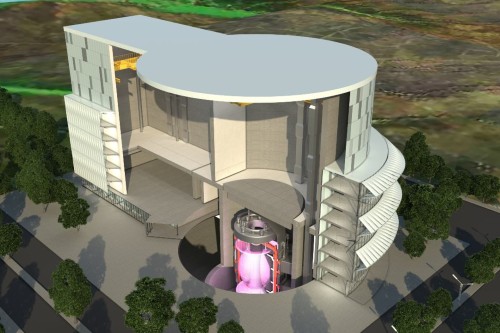Bristol researchers will lead one of six new projects looking at novel ways to reduce the UK’s greenhouse gas emissions, by advancing tritium technology for fusion power stations.
Funding from the Science and Technology Facilities Council (STFC), announced today, will allow scientists to explore ways to turn research into real-world solutions and technologies to help reach Net Zero.
Bristol researchers will address a key technology ‘blocker’ for fusion power stations: tritium monitoring and tracking through the fuel cycle.
The UK aims to be the first country to commercialise fusion energy technology by establishing the STEP (Spherical Tokamak for Energy Production) programme to build a prototype compact power plant by 2040.
Fusion power stations will utilise two heavy isotopes of hydrogen – deuterium and tritium – to generate energy from nuclear fusion. Detecting tritium is challenging. With this funding the Bristol team will further develop the capability of their diamond-based detector devices to track tritium - from where it’s produced in the breeder blanket, all the way through the separation and storage areas, back to where the fuel is re-injected into the reactor.
This proof-of-concept proposal is led by the University of Bristol in partnership with the UK Atomic Energy Authority (UKAEA) tritium advanced technology (H3AT) facility.
The research will be led by Cabot Institute for the Environment Low Carbon Energy co-lead Professor Tom Scott, Royal Academy of Engineering Research Chair in Advancing the Fusion Energy Fuel Cycle, alongside Professor Neil Fox and Dr Yannick Verbelen from the School of Physics.
Professor Scott commented:
“This is a fantastic opportunity to develop a very substantial enabling technology for future fusion power stations. Using our diamond-based detector technology that we have been developing for several years, these will be specifically tuned to detect and track tritium through the fusion fuel cycle.
“Fusion power currently offers the best hope we have of producing abundant, clean, cost-effective and safe power in the future. Solving the tritium tracking issue is vital if we are going to get close to realising our global net zero ambitions.”
In 2019 the UK government committed to reducing the UK’s net emissions of greenhouse gases to zero by 2050.
Researchers have been leading this drive towards Net Zero, for example through driving innovation in renewable energy or by creating new technologies to remove greenhouse gases from the atmosphere.
STFC’s early-stage Net Zero Grant funding splits £800,000 for early development of promising technologies and solutions which support the UK’s goal to achieve net zero carbon dioxide emissions.
STFC Executive Chair Professor Mark Thomson said: “We all are responsible for finding ways to reduce our carbon emissions to achieve the government’s Net Zero target, especially in the research and innovation sector.
“One of the ways we are doing that in STFC and across the scientific community is to look at how we conduct experiments and whether there might be more efficient ways of doing this.
“We are also taking some of the cutting-edge techniques used for pioneering research and applying those to solve some of the biggest challenges to becoming a carbon neutral nation.”
